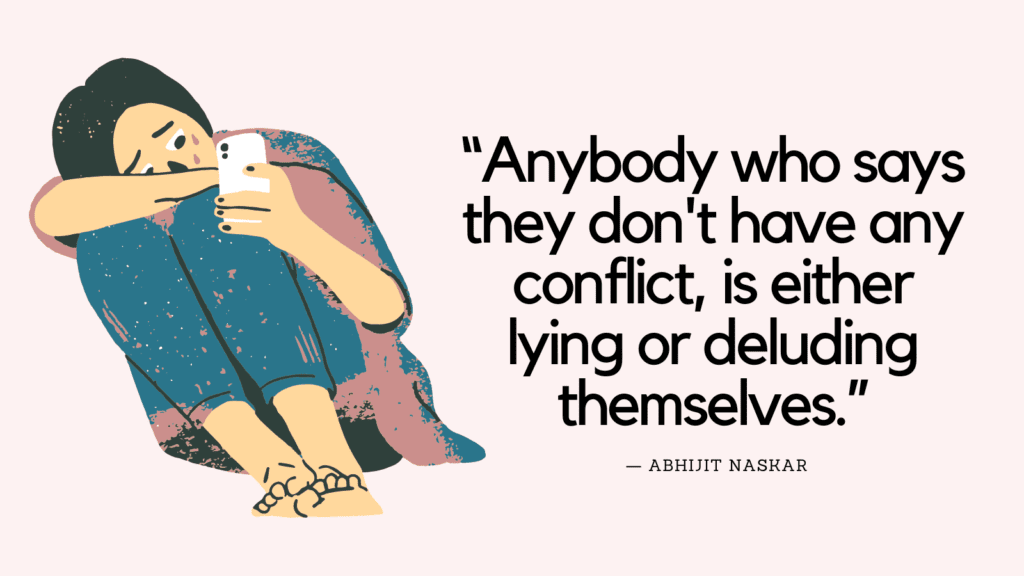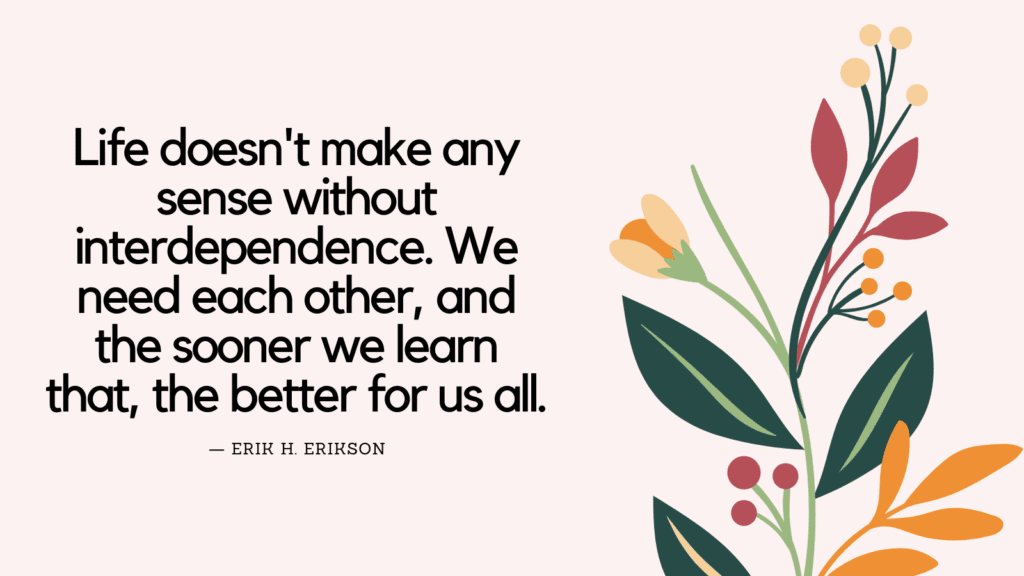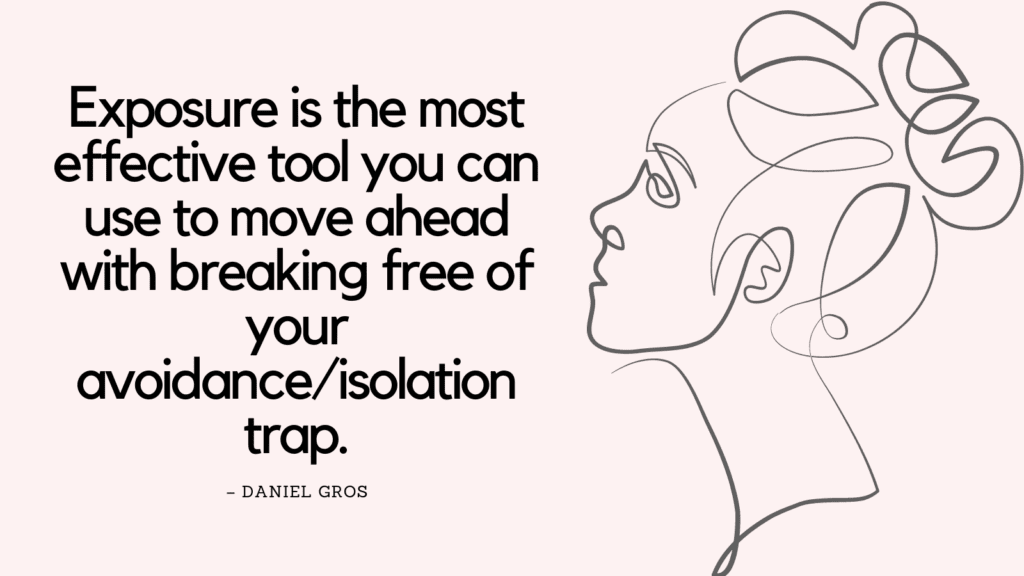This post contains some of the best cognitive dissonance quotes.
What Is Cognitive Dissonance?
The American Psychological Association defines cognitive dissonance as “an unpleasant psychological state resulting from inconsistency between two or more elements in a cognitive system.” (source)
For example, you may smoke even though you know you’re hurting yourself, but you try to rationalize your smoking by pointing to how stressful your job is.
Common signs that what you’re feeling could be related to dissonance include:
- Discomfort before doing something or making a decision
- Doing things because of social pressure that you didn’t want to do
- Experiencing guilt or regret about your actions
- Feeling embarrassed or ashamed about your actions or trying to hide your actions from other people
- Trying to justify or rationalize your decisions or actions
Cognitive Dissonance Quotes
1. “The state of cognitive dissonance occurs when people believe that two of their psychological representations are inconsistent with each other. More formally, a pair of cognitions is inconsistent if one cognition follows from the obverse (opposite) of the other. An example will help: A person believes that he should give money to the poor but he passes by an indigent person on the street without contributing money to the man’s cup. These two cognitions are dissonant because not giving money follows from the obverse of his belief. Not giving money follows logically from a belief that one should not contribute to the poor. But, in our example, the person held a belief that did not coincide with his behavior. We can say that the two cognitions were inconsistent or dissonant with each other.” – Joel Cooper
2. “A mind that has no conflict, is not alive.” ― Abhijit Naskar
3. “Anybody who says they don’t have any conflict, is either lying or deluding themselves.” ― Abhijit Naskar
Related: What Causes Cognitive Distortions? (+Top 10 Common Cognitive Distortions & How To Challenge Them)
4. “Cognitive dissonance is a ubiquitous phenomenon. We make choices all of the time. Choosing among consumer items was merely a way to assess dissonance in the laboratory. However, in the real world, we make many decisions everyday. At universities, we choose courses to take, courses to teach, books to buy. At home, we choose television programs to watch, vacations to take, and even automobiles to purchase. Each time we make one of those decisions, we are subjected to the experience of cognitive dissonance and we are likely to take action to reduce it.” – Joel Cooper
5. “Does my existence constantly cause cognitive dissonance in you?” ― Et Imperatrix Noctem
6. “Even though you have made a rational choice – the best you could have made in the circumstance – you nonetheless experience the unpleasant emotional state of cognitive dissonance.” – Joel Cooper
7. “If you’ve convinced yourself that a market correction is likely (your belief) to justify holding cash rather than investing (your action), you may be under the influence of cognitive dissonance.” ― Coreen T. Sol
8. “My cognition about my attitude, on the other hand, is more fluid and flexible. If I come to believe that I don’t really support giving money to the poor, then my opinion will have been consistent with my behavior. The cognitive dissonance that was aroused because of the discrepancy between my attitude and my behavior would no longer exist.” – Joel Cooper
9. “One of the brilliant innovations of cognitive dissonance theory was its use of a relatively new concept called ‘cognition.’ A cognition is any ‘piece of knowledge’ a person may have. It can be knowledge of a behavior, knowledge of one’s attitude, or knowledge about the state of the world. Anything that can be thought about is grist for the dissonance mill.” – Joel Cooper
10. “One way of reducing cognitive dissonance was to find something wonderful about the experience that would be consistent with, or justify, the suffering.” – Joel Cooper
Related: Top 10 Practical CBT Exercises For Generalized Anxiety Disorder Relief
11. “So, the magnitude of cognitive dissonance will depend on the degree of discrepancy between the two cognitions. The greater the discrepancy, the greater the discomfort, and the more motivated I will be to reduce it.” – Joel Cooper
12. “The discrepancy between believing the task was boring but saying it was exciting created cognitive dissonance. But dissonance is not just about discrepancy. It is also about cognitions consistent with the behavior.” – Joel Cooper
13. “The holding of two or more inconsistent cognitions arouses the state of cognitive dissonance, which is experienced as uncomfortable tension. This tension has drive-like properties and must be reduced.” – Leon Festinger
14. “The inconsistency between attitude and belief would bring about the unpleasant state of cognitive dissonance.” – Joel Cooper
15. “The more important the discrepant cognitions, the more cognitive dissonance I will experience. The more important the consonant cognitions, the less will be my cognitive dissonance.” – Joel Cooper
16. “You’re upset, partly because the evening did not go well, but also because of the inconsistency between your expectation and your experience. You are suffering from the uncomfortable, unpleasant state of cognitive dissonance.” – Joel Cooper
17. “When there is inconsistency in belief and action (such as being violated by someone who is supposed to love you) our mind has to make an adjustment so that thought and action are aligned. So sometimes the adjustment that the mind makes is for the victim to bring her or his behavior in line with the violator, since the violator cannot be controlled by the victim. Our greatest source of survival is to adapt to our environment. So increasing emotional intimacy with a person who is forcing physical intimacy makes sense in our minds. It resolves cognitive dissonance.” ― Rosenna Bakari
Related: How To Stop Self-Critical Thoughts Using These Top 10 Techniques
18. “People who think highly of themselves and expect to succeed would suffer dissonance by failing, but people who think poorly of their ability might experience dissonance from success.” – Joel Cooper
19. “Cognitive dissonance was based on an idea of what occurs inside people’s heads. Inconsistent cognitions caused tension, the tension is arousing and experienced as an unpleasant state, and people are driven to reduce it.” – Joel Cooper
20. “We change our attitudes and cognitions at the service of relieving the aversive, uncomfortable arousal state of cognitive dissonance.” – Joel Cooper
21. “In conclusion, if responsibility cannot easily be denied, if the essay-writing behavior was freely chosen and the consequence was foreseeable, then responsibility is accepted, and the state of cognitive dissonance is aroused.” – Joel Cooper
Related: High Functioning Anxiety Test (& How To Support Anxiety Recovery)

How to Address Cognitive Dissonance?
Cognitive dissonance can be a challenging experience to navigate, but there are strategies that can help address cognitive dissonance.
Here are a few suggestions:
1. Self-reflection
Take the time to reflect on your thoughts, beliefs, and actions.
Analyze why the dissonance exists and what specifically is causing it.
Consider the underlying values that are in conflict and try to understand their origins and importance to you.
2. Seek information
Gather more information about the topic or situation that is causing the cognitive dissonance.
This can include reading books, articles, or seeking out reputable sources of information to help you better understand different perspectives and potentially resolve the dissonance.
3. Challenge and reevaluate beliefs
Evaluate the evidence supporting each conflicting belief. Are there logical fallacies or biases influencing your thinking? Consider the quality and reliability of the information you have based your beliefs on.
Train yourself to be open-minded and willing to consider new information. Challenge yourself to think critically and question deeply held assumptions or biases.
4. Seek social support
Discuss your thoughts and experiences with trusted friends, family members, or professionals who can provide different perspectives and support.
Engaging in open and respectful dialogue can help you gain insights and consider alternative viewpoints.
5. Take action
Once you have identified the source of the cognitive dissonance, consider taking action aligned with your revised beliefs or values.
This might involve making changes in your behavior, seeking opportunities for personal growth, or taking steps to address any conflicts that contribute to the dissonance.
6. Embrace growth and learning
Recognize that cognitive dissonance can be an opportunity for personal growth and development.
Embracing the discomfort and actively seeking resolution can lead to a deeper understanding of oneself and the world around you.
Conclusion
Cognitive dissonance refers to the discomfort that arises when there is a conflict between our beliefs, attitudes, or values and our actions or other conflicting beliefs.
Addressing cognitive dissonance is a process that takes time and patience.
It’s essential to approach it with an open mind and a willingness to challenge and reassess your beliefs in light of new information or experiences.
If you find the dissonance overwhelming, consider seeking support from a trained mental health professional who can guide you through the process.
References
- Portions of this article were adapted from the book Cognitive Dissonance, © 2007 by Joel Cooper. All rights reserved.



